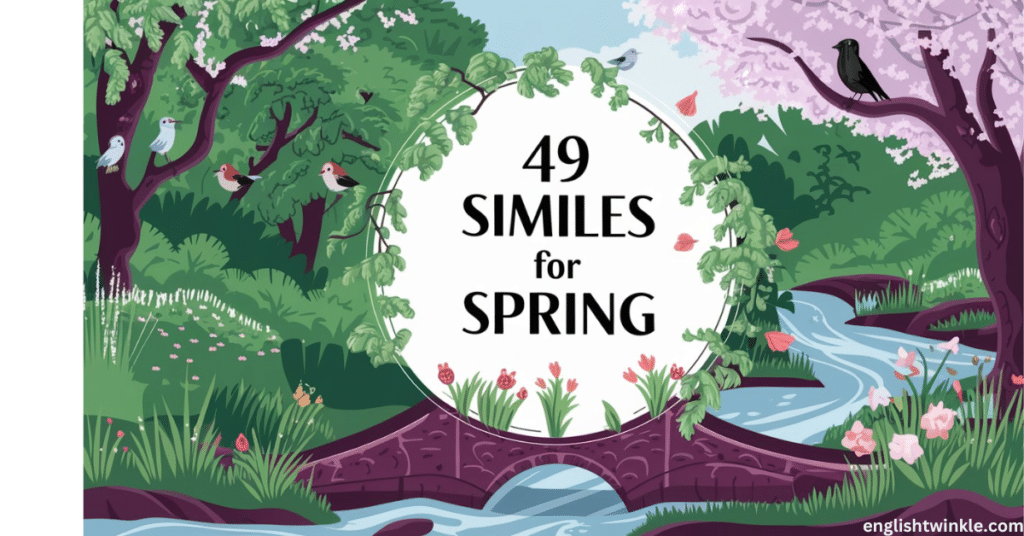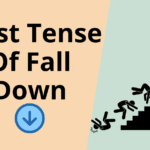Introduction
Spring is a season of renewal, rebirth, and rejuvenation. It’s a time when nature awakens from its winter slumber, bursting forth with vibrant colours, fresh scents, and new life. This makes spring the perfect muse for writers, poets, and anyone looking to add a touch of vivid imagery to their words. In this comprehensive guide, we’ll explore the world of spring similes, delving into their power to evoke the essence of the season and bring our writing to life.
What is a Simile?
Before we dive into our springtime symphony of comparisons, let’s quickly refresh our understanding of similes. A simile is a figure of speech that compares two unlike things using the words “like” or “as.” For example, “Her smile was as bright as the sun” is a simile that compares the radiance of a smile to the brilliance of the sun.
Similes are distinct from metaphors, which make direct comparisons without using “like” or “as.” Similes often feel more accessible and can create a more immediate connection with readers.
The Power of Spring Similes
Spring similes are particularly effective because they tap into a shared experience of the season. When we use spring similes, we’re not just describing something – we’re evoking a whole sensory experience. Let’s explore why spring is such a fertile ground for similes:
- Visual richness: Spring offers a palette of vibrant colours and striking visual contrasts. From the first green shoots pushing through the soil to the explosion of colourful blooms, spring provides endless visual inspiration.
- Sensory abundance: The season engages all our senses with new scents, sounds, and textures. The fragrance of blooming flowers and the feel of warm sunlight on skin after a long winter all contribute to spring’s sensory tapestry.
- Emotional resonance: Spring often symbolizes hope, renewal, and fresh starts. This emotional connection makes spring similes particularly powerful for conveying complex feelings and experiences.
- Universal appeal: Regardless of location, most people have some experience with spring’s transformative power. This universality makes spring similes relatable to a wide audience.
- Dynamic nature: Spring is a season of change and growth, providing a wealth of active, vibrant imagery for similes.
Categories of Spring Similes
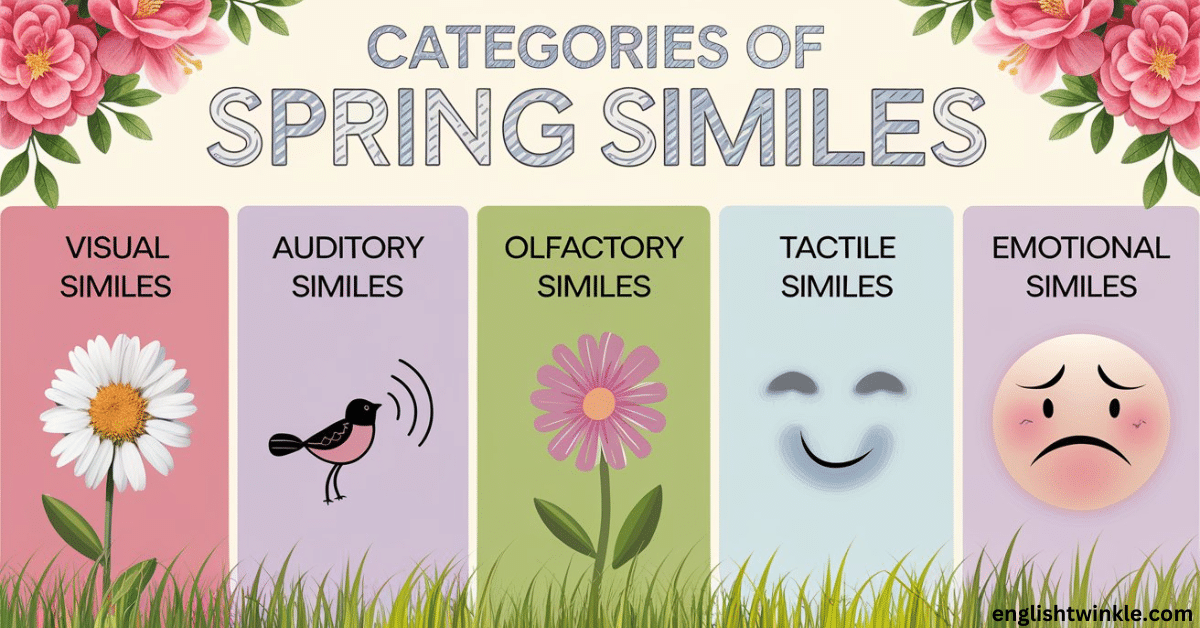
To help us navigate the lush landscape of spring similes, let’s categorise them based on the senses they evoke:
Visual Similes
These similes paint a picture in the reader’s mind, drawing comparisons to the visual aspects of spring:
- Bright as a daffodil in April
- Green as new leaves in spring
- Like a rainbow after a spring shower
- As colourful as a spring garden in full bloom
- Clear as a springtime sky
Visual similes are particularly effective in descriptive writing, helping readers to “see” the scene or object being described. They can bring static descriptions to life, adding depth and dimension to your writing.
Auditory Similes
Spring has its own soundtrack, and these similes capture the sounds of the season:
- Like a songbird singing at dawn
- Clear as a babbling spring brook
- As melodious as a spring peeper chorus
- Noisy as a flock of returning geese
- Quiet as the first spring rain
Auditory similes can add another layer of sensory detail to your writing, helping to create a more immersive experience for the reader. They’re particularly useful in setting a scene or describing an atmosphere.
Olfactory Similes
The scents of spring are distinctive and evocative, perfect for creating vivid comparisons:
- Sweet as the scent of a spring flower
- Fragrant as a field of blooming lavender
- Fresh as newly mown grass
- Like the earthy smell after a spring rain
- As invigorating as the scent of spring air
Olfactory similes can be incredibly powerful, as our sense of smell is closely linked to memory and emotion. Using these similes can evoke strong feelings and associations in your readers.
Tactile Similes
These similes engage our sense of touch, describing textures and sensations associated with spring:
- Soft as a springtime breeze
- Light as a feather in the spring air
- Warm as the first spring sunshine
- Gentle as a spring mist
- Refreshing as spring rain on your face
Tactile similes can help readers feel more connected to the writing, as they engage the physical senses. They’re particularly effective when describing experiences or sensations.
Emotional and Mood-Related Similes
Spring often evokes particular emotions and moods, which these similes capture:
- Cheerful as a child flying a kite in spring
- Alive as the earth in springtime
- Hopeful as the first spring blossom
- Energetic as a spring lamb
- Renewed like nature in springtime
Emotional similes can help convey complex feelings and moods, making abstract concepts more concrete and relatable for readers.
49 Vibrant Spring Similes: A Detailed Exploration
Now, let’s delve into our list of 49 spring similes, complete with meanings and examples. We’ll present these in a table format for easy reference, grouped by themes to showcase the diversity of spring-inspired comparisons.
Flora-Inspired Similes
| Simile | Meaning | Example in Context |
|---|---|---|
| Blooming like wildflowers | Flourishing abundantly | Her creativity was blooming like wildflowers in spring, with ideas sprouting in every direction. |
| Bright as a daffodil | Cheerful and vivid | After the good news, his smile was as bright as a daffodil in full bloom. |
| Like a cherry blossom in full bloom | Delicate and beautiful, but fleeting | Their romance was like a cherry blossom in full bloom – breathtakingly beautiful but all too brief. |
| Green as new leaves | Fresh and vibrant | The novice’s enthusiasm was as green as new leaves, untarnished by cynicism. |
| Delicate as a cherry blossom petal | Extremely fragile and refined | Her touch was delicate as a cherry blossom petal, gentle and soothing. |
| Fragrant as a field of blooming lavender | Intensely aromatic | The spring air was fragrant as a field of blooming lavender, filling the senses with calm. |
| As vibrant as a tulip field | Colourful and lively | The festival was as vibrant as a tulip field, with a dazzling array of sights and sounds. |
| Fresh as a spring daisy | New and unspoiled | Even after years on the job, her approach was as fresh as a spring daisy. |
| Prolific as dandelions in spring | Abundant and widespread | Good ideas were as prolific as dandelions in spring during the brainstorming session. |
| As transformative as a seed becoming a flower | Undergoing significant change | His journey from novice to expert was as transformative as a seed becoming a flower. |
Fauna-Inspired Similes
| Simile | Meaning | Example in Context |
|---|---|---|
| Like a butterfly emerging from a cocoon | Transformative and beautiful | After years of hard work, she emerged like a butterfly from a cocoon, confident and ready to soar. |
| Like a songbird singing at dawn | Joyful and melodious | His laughter was like a songbird singing at dawn, lifting everyone’s spirits. |
| Like a young lamb frolicking in a meadow | Playful and carefree | The children were like young lambs frolicking in a meadow, their joy infectious. |
| Busy as a bee in springtime | Extremely industrious | As the deadline approached, the office was as busy as a bee in springtime. |
| Graceful as a swan on a spring lake | Elegant and poised | Her movements were as graceful as a swan on a spring lake, captivating the audience. |
| Energetic as a spring hare | Full of vitality | After his vacation, he returned to work as energetic as a spring hare. |
| As determined as a robin building a nest | Persistent and focused | She approached her goals as determined as a robin building a nest, undeterred by setbacks. |
| Adaptable as a chameleon in spring foliage | Quick to adjust | In the rapidly changing market, their strategy was as adaptable as a chameleon in spring foliage. |
| As social as spring peepers | Gregarious and vocal | The networking event was as social as spring peepers, with conversations buzzing everywhere. |
| Protective as a mother bear with spring cubs | Fiercely defensive | When it came to her team, she was as protective as a mother bear with spring cubs. |
Poetic Aspect Of Similes
| Simile | Meaning | Example in Context |
|---|---|---|
| Like a butterfly emerging from a cocoon | Transformative and beautiful | After years of hard work, she emerged like a butterfly from a cocoon, confident and ready to soar. |
| Like a songbird singing at dawn | Joyful and melodious | His laughter was like a songbird singing at dawn, lifting everyone’s spirits. |
| Like a young lamb frolicking in a meadow | Playful and carefree | The children were like young lambs frolicking in a meadow, their joy infectious. |
| Busy as a bee in springtime | Extremely industrious | As the deadline approached, the office was as busy as a bee in springtime. |
| Graceful as a swan on a spring lake | Elegant and poised | Her movements were as graceful as a swan on a spring lake, captivating the audience. |
| Energetic as a spring hare | Full of vitality | After his vacation, he returned to work as energetic as a spring hare. |
| As determined as a robin building a nest | Persistent and focused | She approached her goals as determined as a robin building a nest, undeterred by setbacks. |
| Adaptable as a chameleon in spring foliage | Quick to adjust | In the rapidly changing market, their strategy was as adaptable as a chameleon in spring foliage. |
| As social as spring peepers | Gregarious and vocal | The networking event was as social as spring peepers, with conversations buzzing everywhere. |
| Protective as a mother bear with spring cubs | Fiercely defensive | When it came to her team, she was as protective as a mother bear with spring cubs. |
Weather Phenomena Similes
| Simile | Meaning | Example in Context |
|---|---|---|
| Fresh as a morning breeze in spring | Invigorating and new | Her ideas were as fresh as a morning breeze in spring, breathing new life into the project. |
| As refreshing as a spring rain | Revitalising and cleansing | The change in management was as refreshing as a spring rain, washing away old tensions. |
| Clear as a springtime sky | Transparent and unblemished | His explanation was as clear as a springtime sky, leaving no room for confusion. |
| Like a rainbow after a spring shower | Hopeful and vibrant | Their reconciliation was like a rainbow after a spring shower, bringing color back to their relationship. |
| Sparkling as a spring morning’s dewdrops | Glistening and pure | Her eyes were sparkling as a spring morning’s dewdrops, full of wonder and excitement. |
| Unpredictable as spring weather | Changeable and capricious | His moods were as unpredictable as spring weather, sunny one moment and stormy the next. |
| As cleansing as a spring flood | Powerfully renewing | The company’s restructuring was as cleansing as a spring flood, sweeping away outdated practices. |
| Gentle as a spring mist | Soft and unobtrusive | Her guidance was gentle as a spring mist, subtly shaping their development. |
| As inevitable as spring following winter | Certain and unavoidable | Change in the industry was as inevitable as spring following winter. |
| Rejuvenating as the first warm day of spring | Invigorating and uplifting | The team-building retreat was as rejuvenating as the first warm day of spring. |
Natural Phenomena Similes
| Simile | Meaning | Example in Context |
|---|---|---|
| Fresh as a morning breeze in spring | Invigorating and new | Her ideas were as fresh as a morning breeze in spring, breathing new life into the project. |
| As refreshing as a spring rain | Revitalising and cleansing | The change in management was as refreshing as a spring rain, washing away old tensions. |
| Clear as a springtime sky | Transparent and unblemished | His explanation was as clear as a springtime sky, leaving no room for confusion. |
| Like a rainbow after a spring shower | Hopeful and vibrant | Their reconciliation was like a rainbow after a spring shower, bringing color back to their relationship. |
| Sparkling as a spring morning’s dewdrops | Glistening and pure | Her eyes were sparkling as a spring morning’s dewdrops, full of wonder and excitement. |
| Unpredictable as spring weather | Changeable and capricious | His moods were as unpredictable as spring weather, sunny one moment and stormy the next. |
| As cleansing as a spring flood | Powerfully renewing | The company’s restructuring was as cleansing as a spring flood, sweeping away outdated practices. |
| Gentle as a spring mist | Soft and unobtrusive | Her guidance was gentle as a spring mist, subtly shaping their development. |
| As inevitable as spring following winter | Certain and unavoidable | Change in the industry was as inevitable as spring following winter. |
| Rejuvenating as the first warm day of spring | Invigorating and uplifting | The team-building retreat was as rejuvenating as the first warm day of spring. |
Celestial and Light-Related Similes
| Simile | Meaning | Example in Context |
|---|---|---|
| Bright as a sunbeam through the clouds | Piercing and hopeful | His optimism was bright as a sunbeam through the clouds, cutting through the gloom. |
| Radiant as a spring sunrise | Glowing and full of promise | She walked down the aisle, radiant as a spring sunrise, full of hope for the future. |
| As warming as spring sunshine | Comforting and nurturing | Her presence was as warming as spring sunshine, bringing comfort to those around her. |
| Luminous as a full moon in spring | Softly brilliant | The idea was luminous as a full moon in spring, gently illuminating the path forward. |
| As promising as lengthening spring days | Increasingly positive | The project’s outlook was as promising as lengthening spring days, improving steadily. |
| Dazzling as spring sunlight on water | Brilliantly eye-catching | Her performance was dazzling as spring sunlight on water, captivating the audience. |
| As rejuvenating as morning light in spring | Refreshing and energising | The new policy was as rejuvenating as morning light in spring, invigorating the entire organization. |
| Ethereal as spring twilight | Delicate and otherworldly | The music was ethereal as spring twilight, transporting listeners to another realm. |
| As cyclical as the spring equinox | Regularly recurring | Their success was as cyclical as the spring equinox, reliably returning year after year. |
| Illuminating as the first clear night of spring | Revealing and clarifying | Her explanation was illuminating as the first clear night of spring, making complex concepts understandable. |
Human Activities and Emotions
| Simile | Meaning | Example in Context |
|---|---|---|
| Cheerful as a child flying a kite in spring | Carefree and joyous | Despite the challenges, he remained as cheerful as a child flying a kite in spring. |
| Like a burst of color in a gray world | Sudden and vivid improvement | Her presence was like a burst of colour in a Gray world, bringing life to the dull office. |
| As liberating as shedding winter clothes | Freeing and unburdening | Finishing the project felt as liberating as shedding winter clothes on the first warm spring day. |
| Hopeful as a gardener planting seeds | Optimistic about future growth | The investors were as hopeful as gardeners planting seeds, anticipating future returns. |
| As reinvigorating as spring cleaning | Thoroughly refreshing | The company’s re-branding was as reinvigorating as spring cleaning, clearing out the old and making room for the new. |
| Playful as children on the first day of spring break | Exuberantly free | The team’s brainstorming session was as playful as children on the first day of spring break, full of energy and creativity. |
| As promising as a well-tended spring garden | Full of potential | The startup’s future looked as promising as a well-tended spring garden, with growth on the horizon. |
| Enthusiastic as a hiker on the first spring trail | Eager and excited | The new employees were as enthusiastic as hikers on the first spring trail, ready to take on new challenges. |
| As revitalising as a spring makeover | Refreshing and transformative | The office renovation was as revitalising as a spring makeover, boosting morale and productivity. |
| Inspiring as the first outdoor concert of spring | Uplifting and motivational | Her speech was as inspiring as the first outdoor concert of spring, filling the audience with energy and hope. |
Texture and Sensation Similes
| Simile | Meaning | Example in Context |
|---|---|---|
| Light as a feather in the spring air | Effortless and graceful | After shedding her worries, she felt light as a feather in the spring air. |
| Smooth as a spring pond’s surface | Calm and untroubled | His delivery was as smooth as a spring pond’s surface, flowing without a hitch. |
| Soft as new spring grass | Tender and gentle | Her approach to the sensitive issue was soft as new spring grass, careful not to cause harm. |
| Fresh as the first spring breeze | Invigorating and new | The product redesign felt fresh as the first spring breeze, breathing new life into the brand. |
| Crisp as a spring morning | Clean and invigorating | The presentation was crisp as a spring morning, clear and energising. |
| Delicate as spring frost | Fragile and intricate | The negotiations were delicate as spring frost, requiring careful handling. |
| Refreshing as a spring shower | Revitalising and cleansing | The new perspective was refreshing as a spring shower, washing away old assumptions. |
| Tender as spring buds | Vulnerable and full of potential | The new relationships were tender as spring buds, needing nurture to flourish. |
| Invigorating as a spring plunge | Energising and bracing | The sudden challenge was invigorating as a spring plunge, shocking them into action. |
| Warm as spring sunshine | Comforting and nurturing | Her mentorship was warm as spring sunshine, encouraging growth and development. |
The Art of Crafting Effective Spring Similes
Creating powerful spring similes is an art that combines keen observation, creativity, and a deep understanding of the season’s essence. Here are some tips to help you craft your own spring similes:
- Observe nature closely: Take time to really notice the changes that spring brings. What colours, sounds, and scents stand out? How does the quality of light change? What textures emerge in the natural world?
- Think beyond the obvious: While flowers and birds are classic spring imagery, consider less common elements like the texture of new grass, the pattern of melting snow.
- Engage all senses: Don’t just focus on visual comparisons. Think about how spring feels, sounds, smells, and even tastes. The more senses you engage, the more vivid your simile will be.
- Avoid clichés: While “fresh as a daisy” is a well-known spring simile, try to come up with more original comparisons. Look for unexpected connections between spring phenomena and the subject you’re describing.
- Consider emotional associations: Spring often evokes feelings of hope, renewal, and joy. How can you capture these in your similes? Think about how different aspects of spring make you feel and use these emotions in your comparisons.
Master Your Skill
- Be specific: Instead of general terms, use specific types of flowers, birds, or weather phenomena in your similes. “As yellow as a daffodil” is more vivid than “as yellow as a spring flower.”
- Use active language: Spring is a dynamic season. Incorporate verbs into your similes to capture this sense of movement and change. For example, “sprouting like ideas in a brainstorm session” is more energetic than “like ideas in a brainstorm session.”
- Consider your audience: Think about what spring means to your readers.
- Play with contrast: Spring is a season of contrasts – cold and warm, wet and dry, dormant and growing. Use these contrasts in your similes to create tension and interest.
- Experiment with extended similes: Sometimes, a single point of comparison isn’t enough. Try developing your simile into a more extended comparison to fully explore the connection between your subject and the spring element.
Using Spring Similes in Various Forms of Writing
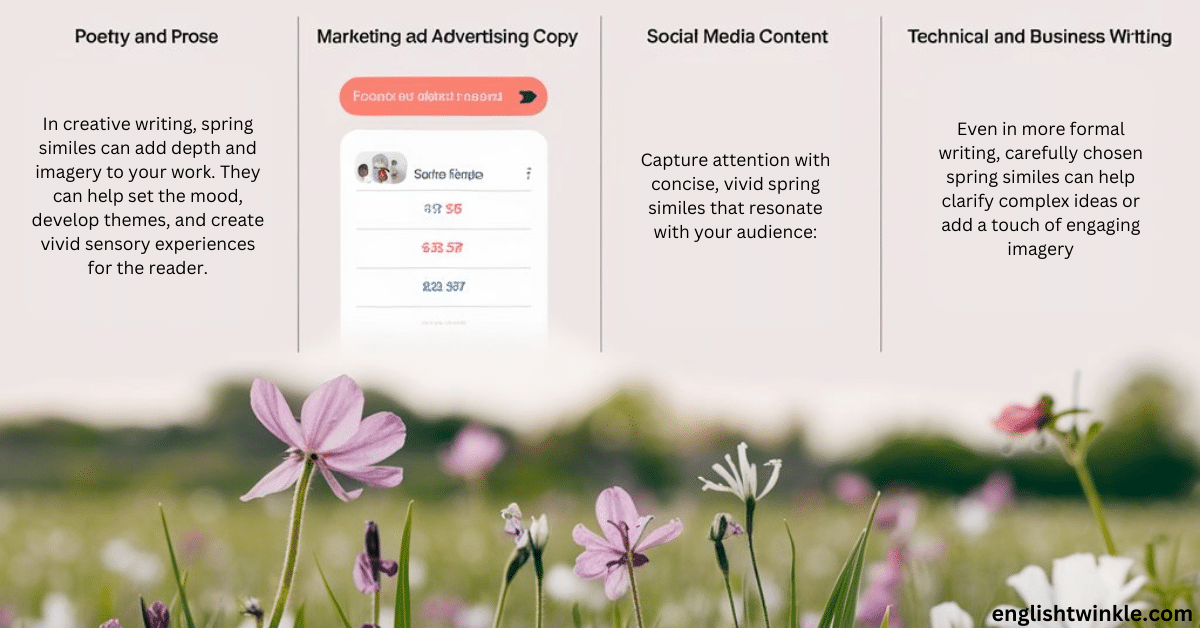
Spring similes can enhance various types of writing. Here’s how you can incorporate them effectively:
Poetry and Prose
In creative writing, spring similes can add depth and imagery to your work. They can help set the mood, develop themes, and create vivid sensory experiences for the reader. For example:
Her hope blossomed like cherry trees in April, Fragile petals unfurling against all odds. Each day a new bud of possibility, As persistent as crocuses pushing through snow.
In prose, spring similes can be used to deepen characterisation, enhance descriptions, or highlight themes of renewal and growth. For instance:
As Sarah stepped out of the office, resignation letter in hand, she felt a surge of freedom. Like the first warm spring breeze, it promised new beginnings and unexplored paths.
Descriptive Essays
Use spring similes to bring your descriptions to life, helping readers visualise and connect with the scene you’re painting:
The campus quad was as vibrant as a meadow in May, students sprawled on the grass like wildflowers soaking up the sun. Laughter bubbled up here and there, as refreshing as a spring brook, while the rustle of turning pages whispered like a gentle breeze through new leaves.
Marketing and Advertising Copy
Spring similes can make your copy more engaging and memorable, helping to create positive associations with your product or service:
Our new spring collection: As fresh as a morning breeze, as vibrant as a field of tulips. Rejuvenate your wardrobe with colours that pop like the first blooms of spring and fabrics as light as a feather on the spring air. Step into the season with confidence, wrapping yourself in the promise of new beginnings.
Social Media Content
Capture attention with concise, vivid spring similes that resonate with your audience:
Monday motivation: Be as resilient as a daffodil pushing through the last snow of winter.
Our customer service team: As responsive as leaves turning to the spring sun, always here to brighten your day.
New product alert! As refreshing as the first spring rain, our latest innovation is here to revitalise your routine.
Technical and Business Writing
Even in more formal writing, carefully chosen spring similes can help clarify complex ideas or add a touch of engaging imagery:
For instance, the new software update streamlines the user interface, making navigation as intuitive as a bee finding flowers in spring. As a result, this efficiency boost is expected to increase productivity as steadily as lengthening spring days.
Our adaptive business model responds to market changes like a forest leafing out in spring, ensuring we stay vibrant and relevant in a changing landscape.
The Impact of Spring Similes on Reader Engagement
Using spring similes effectively can significantly enhance reader engagement in several ways:
- Emotional resonance: Spring similes often evoke positive emotions associated with renewal, growth, and fresh starts. This emotional connection can help readers engage more deeply with the text and remember it more vividly.
- Improved imagery: Vivid comparisons help readers visualise concepts more clearly. By linking ideas to tangible, sensory experiences of spring, writers can make even abstract concepts more concrete and relatable.
- Enhanced memory: Unique and striking similes are more likely to stick in readers’ minds. When information is tied to a memorable image or sensory experience, it becomes easier to recall.
- Increased relatability: By drawing comparisons to common spring experiences, writers can make abstract ideas more accessible. This can be particularly useful when explaining complex concepts or trying to connect with a broad audience.
- Sensory engagement: Spring similes often engage multiple senses, creating a more immersive reading experience. This multi-sensory approach can lead to deeper understanding and stronger connections with the material.
- Cognitive links: Similes create cognitive links between different ideas or experiences. This can help readers grasp new concepts by relating them to familiar experiences of spring.
- Mood enhancement: The generally positive associations of spring can lift the overall mood of a piece of writing, making it more enjoyable to read.
- Cultural resonance: Spring has significance in many cultures, often symbolising renewal, hope, and new beginnings. Spring similes can tap into these cultural meanings, adding depth to the writing.
- Pacing and rhythm: Well-placed similes can help vary the rhythm of writing, providing moments of pause for reflection or bursts of vivid imagery that keep the reader engaged.
- Memorability: A particularly apt or creative spring simile can become a “sticky” idea that readers remember and potentially share with others.
Case Study: The Power of Spring Similes in Literature
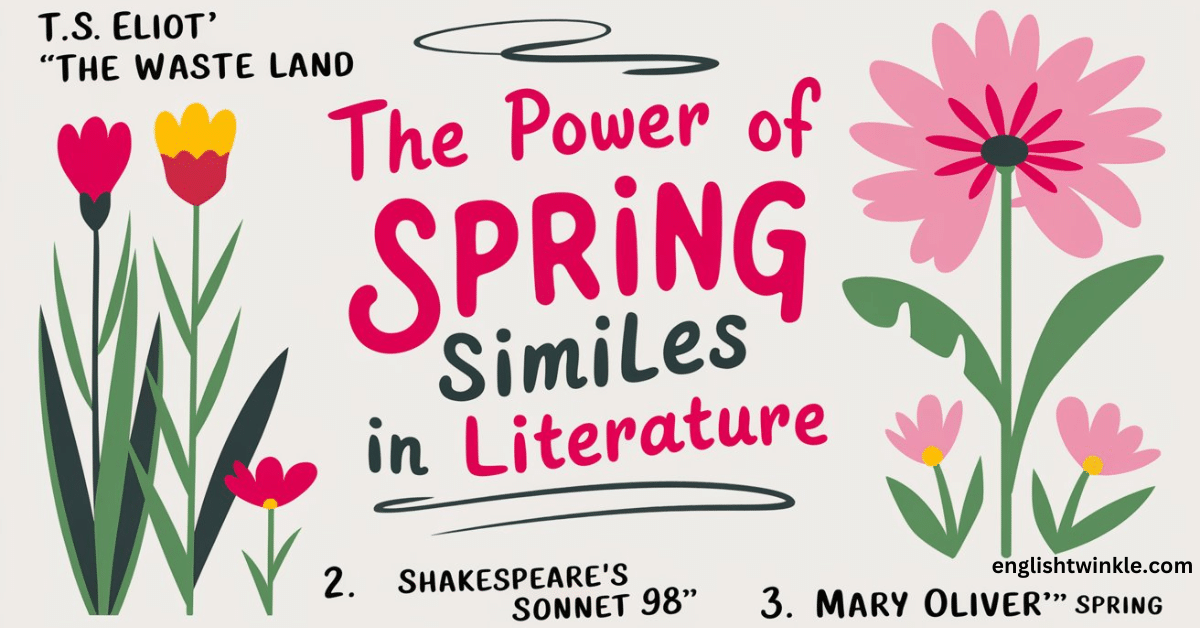
Let’s look at how master writers have used spring similes to create lasting impressions:
T.S. Eliot’s “The Waste Land”
“April is the cruelest month, breeding Lilacs out of the dead land, mixing Memory and desire, stirring Dull roots with spring rain.”
Here, Eliot uses the simile of spring rain stirring dull roots to evoke the sometimes painful process of renewal and growth. This unexpected portrayal of spring as “cruel” challenges the reader’s expectations, making the imagery all the more powerful.
The simile works on multiple levels:
- It captures the physical process of plants growing after winter dormancy.
- It suggests emotional and psychological awakening, which can be uncomfortable.
- It hints at the broader theme of rebirth and renewal in the poem.
Shakespeare’s Sonnet 98
“From you have I been absent in the spring, When proud-pied April, dressed in all his trim, Hath put a spirit of youth in everything, That heavy Saturn laughed and leaped with him.”
Shakespeare personifies April as a proud, well-dressed youth, using this extended simile to contrast the vibrancy of spring with the speaker’s melancholy due to absence from their loved one.
This simile works effectively because:
- It brings spring to life as a character, making the season’s effects more tangible.
- The contrast between youthful April and “heavy Saturn” (traditionally associated with old age and melancholy) emphasizes the transformative power of spring.
- The image of Saturn laughing and leaping captures the joy and renewal of spring in a surprising and memorable way.
Mary Oliver’s “Spring”
“There is something about the way the wrens sing, in the deep and damp morning, that is like my grandmother’s fingers touching my forehead when I had a fever.”
Oliver’s simile comparing birdsong to a grandmother’s comforting touch is unexpected yet deeply evocative. It works well because:
- It connects a natural phenomenon (birdsong) with a deeply personal, emotional experience.
- The simile engages multiple senses: sound (the wrens singing), touch (fingers on forehead), and even the implied sense of comfort and care.
- It captures the nurturing, renewing aspect of spring in a unique and touching way.
These examples demonstrate how powerful spring similes can be when crafted thoughtfully and creatively. They show that spring similes can do more than just describe; they can evoke complex emotions, challenge expectations, and create lasting impressions on readers.
Interactive Elements: Test Your Spring Simile Knowledge
Now that we’ve explored the world of spring similes, let’s test your understanding with a quick quiz:
- What season is compared to “a butterfly emerging from a cocoon”?
- Complete this simile: “Clear as a __ sky”
- What flower is often used in similes to represent brightness?
- What spring phenomenon is used in similes to represent refreshment?
- How might you describe something very light using a spring simile?
- What bird is often used in similes to represent joyful sounds?
- Complete this simile: “Green as __ leaves”
- What spring weather phenomenon is used to represent hope after difficulties?
- How might you describe something unpredictable using a spring simile?
- What spring activity is used in similes to represent thorough renewal?
(Answers: 1. Spring, 2. Springtime, 3. Daffodil, 4. Spring rain, 5. Light as a feather in the spring air, 6. Songbird, 7. New, 8. Rainbow after a spring shower, 9. Unpredictable as spring weather, 10. Spring cleaning)
Writing Prompt: Create Your Own Spring Simile
Now it’s your turn! Use the following prompts to create your own spring similes:
- Think of a personal quality or emotion. How might you compare it to an aspect of spring? Example: “Her kindness was like the first warm day of spring, melting away people’s defences.”
- Consider a current event or social issue. Can you draw a comparison to a spring phenomenon? Example: “The spread of misinformation is like pollen on a spring breeze, drifting far and wide.”
- Take an everyday object and describe it using a spring simile. Example: “The old car’s engine sputtered to life like the first bumblebee of spring, groggy but determined.”
- Think about a personal goal or aspiration. How could you express it using a spring simile? Example: “My determination to learn a new skill is like a crocus pushing through late snow – persistent and full of the promise of growth.”
- Describe a complex emotion using spring similes. Example: “His mood was as changeable as spring weather, sunny one moment and stormy the next, with bursts of rainbow-like joy breaking through melancholy clouds.”
Remember, the key to a good simile is finding an unexpected yet apt comparison that illuminates your subject in a new and interesting way.
The Enduring Appeal of Spring Similes
Spring similes offer a unique blend of universality and personal connection. On one hand, they tap into shared experiences of renewal and growth, while on the other, they allow for individual interpretation and creativity. Consequently, these similes serve as both a common language and a canvas for personal expression. By mastering the art of spring similes, writers can:
- Bring their words to life with vivid, sensory-rich language
- Create emotional connections with readers
- Make abstract concepts more concrete and relatable
- Add a touch of poetry to everyday communication
- Enhance memory and recall of key points
- Engage readers on multiple sensory and cognitive levels
- Tap into cultural associations with renewal and hope
Conclusion
As we’ve seen, the possibilities for spring similes are as endless as the season’s capacity for renewal. Whether you’re a poet, a marketer, or simply someone who loves language, incorporating spring similes into your writing can add a fresh burst of creativity and engagement.
Spring similes remind us of nature’s power to inspire and connect. They bridge the gap between the natural world and our experiences, echoing our lives in the seasons’ rhythms. In a disconnected world, they help us reconnect, reminding us of growth, renewal, and transformation.
Crafting spring similes sharpens our observational skills and, in turn, deepens our appreciation for the world around us. Moreover, this practice encourages us to notice subtle seasonal changes, from shifting light to new scents in the air.
Further Reading and Resources
To deepen your understanding and mastery of figurative language, including similes, consider exploring these resources:
- “The Art of Simile: How to Make Your Writing Sizzle” by Roy Peter Clark.
- “Spring: A Spiritual Biography of the Season” edited by Gary Schmidt and Susan M. Felch.
- “The Poetry Home Repair Manual: Practical Advice for Beginning Poets” by Ted Kooser.
- “Metaphors We Live By” by George Lakoff and Mark Johnson.
- “The Writer’s Portable Mentor: A Guide to Art, Craft, and the Writing Life” by Priscilla Long.
- “A Poetry Handbook” by Mary Oliver Insights from a master poet on crafting evocative language, including the use of similes.
- Online resources:
- Poetry Foundation: Offers a wealth of poems that may inspire your use of spring similes.
- National Geographic’s spring content: Provides beautiful imagery and information about spring phenomena to fuel your similes.
- Local nature centers or botanical gardens: Many offer spring-themed workshops or guided walks that can enhance your observational skills.
Remember, the best way to improve your use of spring similes is through practice and observation. Take time to experience spring with all your senses, and let nature be your guide in crafting beautiful, evocative comparisons. Keep a journal of spring observations and simile ideas, and don’t be afraid to experiment with unexpected connections. With time and practice, your writing will blossom with the vibrancy and freshness of spring itself.

